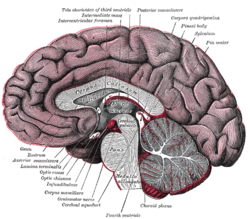
Back جسم ثفني Arabic Cuerpu callosu AST Korf karnek Breton Žuljevito tijelo BS Cos callós Catalan Kalózní těleso Czech Hjernebjælke Danish Corpus callosum German Kaloza korpo Esperanto Cuerpo calloso Spanish
| Corpus callosum | |
|---|---|
 Corpus callosum from above, front part at the top of the image | |
 Sagittal section of a brain, front part to the left. The corpus callosum can be seen in the center, in light gray | |
| Details | |
| Pronunciation | /ˈkɔːrpəs kəˈloʊsəm/ |
| Part of | Human brain |
| Location | Between the two brain hemispheres |
| Parts | Genu, rostrum, trunk, splenium |
| Function | Facilitating communication between the two brain hemispheres, allowing them to share information and coordinate functions like movement, sensory processing, and cognitive tasks |
| Identifiers | |
| MeSH | D003337 |
| NeuroNames | 191 |
| NeuroLex ID | birnlex_1087 |
| TA98 | A14.1.09.241 |
| TA2 | 5604 |
| FMA | 86464 |
| Anatomical terms of neuroanatomy | |
The corpus callosum (Latin for "tough body"), also callosal commissure, is a wide, thick nerve tract, consisting of a flat bundle of commissural fibers, beneath the cerebral cortex in the brain. The corpus callosum is only found in placental mammals.[1] It spans part of the longitudinal fissure, connecting the left and right cerebral hemispheres, enabling communication between them. It is the largest white matter structure in the human brain, about 10 cm (3.9 in) in length and consisting of 200–300 million axonal projections.[2][3]
A number of separate nerve tracts, classed as subregions of the corpus callosum, connect different parts of the hemispheres. The main ones are known as the genu, the rostrum, the trunk or body, and the splenium.[4]
- ^ Velut, S; Destrieux, C; Kakou, M (May 1998). "[Morphologic anatomy of the corpus callosum]". Neuro-Chirurgie. 44 (1 Suppl): 17–30. PMID 9757322.
- ^ "Corpus callosum". Queensland Brain Institute. 10 November 2017.
- ^ Luders, Eileen; Thompson, Paul M.; Toga, Arthur W. (18 August 2010). "The Development of the Corpus Callosum in the Healthy Human Brain". Journal of Neuroscience. 30 (33): 10985–10990. doi:10.1523/JNEUROSCI.5122-09.2010. PMC 3197828. PMID 20720105.
- ^ Gaillard, Frank. "Corpus callosum | Radiology Reference Article | Radiopaedia.org". radiopaedia.org.